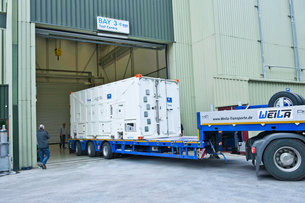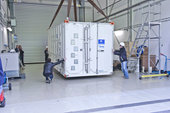16 May 2013
The first satellite of Galileo’s next phase has arrived at ESA’s
technical heart in the Netherlands for a rigorous set of tests to check
its readiness for launch.
This first Galileo Full Operational Capability – FOC – satellite is functionally identical to the first four Galileo In-Orbit Validation satellites already in orbit, the operational nucleus of the full Galileo constellation, but has been built by a separate industrial team.
Like all the other 21 FOC satellites so far procured by ESA, the satellite’s prime contractor is OHB in Bremen, Germany and the navigation payload was produced by Surrey Satellite Technology Ltd in Guildford, UK.
This first FOC satellite arrived by road at ESTEC’s Test Centre in Noordwijk, the Netherlands, on 15 May to undergo a series of tests simulating different aspects of launch and space environment. The comprehensive test programme will validate the new design and all the satellites to follow.
A unique facility for Europe, ESA’s test centre has all the facilities needed to validate a satellite for launch under a single roof.
Thermal vacuum testing will simulate the temperature extremes the satellites must endure in the airlessness of space throughout their 12-year working lifetimes. Without any moderating atmosphere, temperatures can shift hundreds of degrees from sunlight to shadow.
This first Galileo Full Operational Capability – FOC – satellite is functionally identical to the first four Galileo In-Orbit Validation satellites already in orbit, the operational nucleus of the full Galileo constellation, but has been built by a separate industrial team.
Like all the other 21 FOC satellites so far procured by ESA, the satellite’s prime contractor is OHB in Bremen, Germany and the navigation payload was produced by Surrey Satellite Technology Ltd in Guildford, UK.
This first FOC satellite arrived by road at ESTEC’s Test Centre in Noordwijk, the Netherlands, on 15 May to undergo a series of tests simulating different aspects of launch and space environment. The comprehensive test programme will validate the new design and all the satellites to follow.
A unique facility for Europe, ESA’s test centre has all the facilities needed to validate a satellite for launch under a single roof.
Thermal vacuum testing will simulate the temperature extremes the satellites must endure in the airlessness of space throughout their 12-year working lifetimes. Without any moderating atmosphere, temperatures can shift hundreds of degrees from sunlight to shadow.
Other activities on the schedule include shaker and acoustic noise
testing – simulating the vibration and noise of launch – as well as
electromagnetic compatibility and antenna testing, placing the satellite
in chambers shielded from all external radio signals to reproduce
infinite space and check that its various antennas and electrical
systems are interoperable without harmful interference.
Each satellite will offer the full range of Galileo positioning, navigation and timing services, plus search and rescue message relays, their accuracy ensured by onboard atomic clocks kept synchronised by a worldwide ground network.
“The Galileo FOC satellites provide the same capabilities as the previous IOV satellites, but with improved performance, such as higher transmit power,” explains Giuliano Gatti, the Head of the Galileo Space Segment Procurement Office. “They are to all intents a new design that requires a full checkout before getting the green light for launch.
Each satellite will offer the full range of Galileo positioning, navigation and timing services, plus search and rescue message relays, their accuracy ensured by onboard atomic clocks kept synchronised by a worldwide ground network.
“The Galileo FOC satellites provide the same capabilities as the previous IOV satellites, but with improved performance, such as higher transmit power,” explains Giuliano Gatti, the Head of the Galileo Space Segment Procurement Office. “They are to all intents a new design that requires a full checkout before getting the green light for launch.
“By fully validating this satellite, the second flight model due to
follow it here at beginning of June, and the third one due to arrive in
ESTEC at middle of July, we gain full knowledge of their
characteristics, and the further satellites in the series will require
less rigorous functional testing.”
The first four Galileo IOV satellites, launched in 2011 and 2012, were
provided by EADS Astrium with Thales Alenia Space Italy responsible for
integrating the satellites and Astrium in Portsmouth, UK, providing the
navigation payloads. They provided their first navigation fix in March
2013.
The first FOC satellites are due to be launched together on a Soyuz from Europe’s Spaceport in Kourou, French Guiana this autumn, with two more due to follow by the end of the year.
The first FOC satellites are due to be launched together on a Soyuz from Europe’s Spaceport in Kourou, French Guiana this autumn, with two more due to follow by the end of the year.
The definition, development and In-Orbit Validation phases of the
Galileo programme are being carried out by ESA and co-funded with the
European Commission (EC).
The subsequent FOC phase is managed and funded by the EC. The Commission
has delegated the role of design and procurement agent to ESA for the
FOC phase. At the same time as the satellites are being assembled on a
production-line basis, ground stations are also being established on
far-flung European territories around the globe.
European Space Research and Technology Centre (ESTEC) - ESA
ESA has sites in several European countries, but the European Space
Research and Technology Centre (ESTEC) in Noordwijk, the Netherlands, is
the largest. ESTEC is our technical heart - the incubator of the
European space effort - where most ESA projects are born and where they
are guided through the various phases of development.
- Developing and managing all types of ESA missions: science, exploration, telecommmunications, human spaceflight, satellite navigation and Earth observation.
- Providing all the managerial and technical competences and facilities needed to initiate and manage the development of space systems and technologies.
- Operating an environmental test centre for spacecraft, with supporting engineering laboratories specialised in systems engineering, components and materials, and working within a network of other facilities and laboratories.
- Supporting European space industry and working closely with other organisations, such as universities, research institutes and national agencies from ESA Member States, and cooperating with space agencies all over the world.
Hide continue
ESTEC is located in Noordwijk, the Netherlands. Our postal address is:
European Space Research & Technology Centre
Postbus 299
2200 AG Noordwijk (The Netherlands)
Tel: +31 (0)71 565 6565
If you want to get in touch with ESTEC via ESA, please send your question to contactesa @ esa.int.
European Space Research & Technology Centre
Postbus 299
2200 AG Noordwijk (The Netherlands)
Tel: +31 (0)71 565 6565
If you want to get in touch with ESTEC via ESA, please send your question to contactesa @ esa.int.
Last update: 23 March 2010
ESA
Guillermo Gonzalo Sánchez Achutegui
ayabaca@gmail.com
ayabaca@hotmail.com
ayabaca@yahoo.com



No hay comentarios:
Publicar un comentario